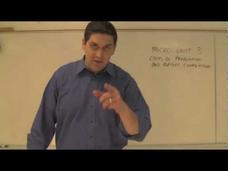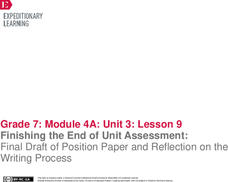Copyright Teacher Resources
Find Copyright lesson plans and worksheets
Showing 11,845 resources
Jacob Clifford
Intro - Costs of Production and Perfect Competition
Here is a brief introduction to the concepts covered in an economics course unit on the costs of production and perfect competition.
LABScI
Photosynthesis: How Do Plants Get Energy?
Examine the mechanism of photosynthesis through different light scenarios. Pupils vary the amount and type of light exposure on plant leaves in the fifth lesson plan in a 12-part series. Through observation, they determine the rate of...
College Board
2011 AP® English Language and Composition Free-Response Questions Form B
Strong writers support their points with direct evidence and details. A series of free-response questions from the 2011 AP® English Language and Composition exam require the use of details to obtain a good score. The first prompt...
EngageNY
Finishing the End of Unit Assessment: Final Draft of Position Paper and Reflection on the Writing Process
Think about it. Writers think about their end of unit essays through reflection. They use the End of Unit 3 Assessment, Part 2: Reflection on the Writing Process handout to analyze the writing process they used to create their...
Curated OER
What Are Newton's Laws?
In this Newton's laws worksheet, students write in 1 main idea and 4 supporting details about Newton's laws of motion. This worksheet is a graphic organizer.
Curated OER
The Artist As Entrepreneur: VARA-visual Artists Rights Act
Students read case studies of artists' lawsuits under the Visual Artists Rights Act and then discuss the merits of fictitious cases where artists might consider a lawsuit. They predict the outcome of a lawsuit scenario and justify their...
Curated OER
The Brief American Pageant: American Life in the Roaring Twenties
Your lecture on the Roaring Twenties in the United States could use these two graphs. The first graph details the annual immigration and Quota Laws from 1907-29, and compares them to the McCarran-Walter Act of 1952. The second graph...
Teach Engineering
Quantifying Refraction
Class members discover how mathematics can quantify the behavior of light waves with the fourth installment of a seven-part series that teaches future engineers about equations related to refraction, including the equation to...
Curated OER
From Sunlight to Electric Current
Students explore concept of current in electrical circuits. They examine how energy from the sun can be used to power everyday items, including vehicles.
Curated OER
Energy Resources
In this energy worksheet, students will review the different types of energy and how energy can be created and conserved. This worksheet has 10 matching and 11 short answer questions.
Deliberating in a Democracy
Surveillance
Big Brother is always watching you! Scholars analyze the impact security cameras have on the legal system in a democracy. Primary documentation, case studies, and video clips investigate the use of video in prosecution and provide an...
Teach Engineering
Spring Away!
The last segment of the nine-part unit makes a connection between springs and linear equations. Groups hang weights from the spring and measure its length. Then, using the data collected, they calculate the slope to find the k-value...
Teach Engineering
The Great Gravity Escape
Groups simulate an orbit using a piece of string and a water balloon. Individuals spin in a circular path and calculate the balloon's velocity when the clothes pin can no longer hold onto the balloon.
Teach Engineering
It's Tiggerific!
Spring into elastic potential energy with a lesson that provides background information on determining the elastic potential energy of springs and other elastic materials. General energy equations emphasize the conservation of...
Teach Engineering
Android Acceleration
Prepare to accelerate your Android. Pupils prep for the upcoming activity in this third installment of a four-part series. The lesson progresses nicely by first introducing different types of acceleration to the class. The teacher...
Teach Engineering
Exploring Energy: Energy Conversion
The energy is not really lost, it is just converted to a different form. Pupils learn about the conversion of energy in the fifth segment of an energy unit with six parts. Learners develop an understanding of the conservation of energy...
Teach Engineering
Energy and the Pogo Stick
Let your class bounce to examine the concept elastic potential energy. Individuals bounce on a pogo stick in order to calculate its elastic potential energy. Groups then compare the elastic potential energy to the gravitational...
Teach Engineering
Energy Storage Derby and Proposal
Small groups use the engineering design process to build and test a vehicle capable of carrying 250 grams a distance of five meters. The design must allow for the storage of potential energy and turn it into motion,...
Teach Engineering
Exploring Acceleration with an Android
Small groups use rubber bands to accelerate an Android device along a track of books. They collect the acceleration data and analyze it in order to determine the device's velocity.
Wind Wise Education
Understanding Forms and Sources of Energy
What is the difference between a form of energy and a source of energy? This first activity in a series of 19 lessons uses demonstrations and discussions to introduce energy to the class. Through using hand-generator flashlights,...
Chymist
Determination of the Volume of CO2 in Pop Rocks
Where does the pop in pop rocks come from? An engaging activity asks scholars to measure the amount of carbon dioxide in a package of Pop Rocks candy. Learners dissolve the candy in water and use the solubility of CO2 to determine its mass.
K12 Reader
How Things Move
As part of a comprehension exercise, kids read a physical science article about motion and then answer a series of comprehension questions based on the passage.
National Geographic
Dr. Martin Luther King, Jr.
Dr. Martin Luther King, Jr. not only paved the way for African American citizens' civil rights, he created an example for women's groups, Hispanic groups, and groups with disabilities to fight for their rights as well. Learn more with a...
CYP Limited
Songwords & Activity Sheets for Under the Sea
Take young learners on an undersea adventure with this fun collection of primary grade activities. Intended to accompany the Kids Under the Sea CD, this resource includes lyrics as well as counting and tracing activities...
Other popular searches
- Copyrights
- Copyright Page
- Fair Use Copyright
- Copyright Disclaimers
- Copyright Policy
- Music Copyright
- Copyright Infringement
- Copyright Concepts
- Copyright Lesson
- Copyright and Fair Use
- Copyright Protection
- Patent Trademark Copyright

























